
Back كونكوردات عام 1801 Arabic Concordat del 1801 Catalan Konkordát (1801) Czech Konkordat von 1801 German Konkordato de 1801 Esperanto Concordato de 1801 Spanish Concordat de 1801 French Konkordat 1801 ID Concordato del 1801 Italian Concordaat van 1801 Dutch



The Concordat of 1801 was an agreement between Napoleon Bonaparte and Pope Pius VII, signed on 15 July 1801 in Paris.[1] It remained in effect until 1905, except in Alsace–Lorraine, where it remains in force. It sought national reconciliation between revolutionaries and Catholics and solidified the Roman Catholic Church as the majority church of France, with most of its civil status restored. This resolved the hostility of devout French Catholics against the revolutionary state. It did not restore the vast Church lands and endowments that had been seized during the French Revolution and sold off. Catholic clergy returned from exile, or from hiding, and resumed their traditional positions in their traditional churches. Very few parishes continued to employ the priests who had accepted the Civil Constitution of the Clergy of the revolutionary regime. While the Concordat restored much power to the papacy, the balance of church-state relations tilted firmly in Napoleon's favour. He selected the bishops and supervised church finances.[2][3]
Napoleon and the Pope both found the Concordat useful. Similar arrangements were made with the Church in territories controlled by Napoleon, especially Italy and Germany.[4]
- ^ Knight, Charles (1867). "Pius VII". Biography: Or, Third Division of The English Encyclopedia. Vol. 4. Bradbury, Evans & Company.
- ^ Aston, Nigel (2000). Religion and revolution in France, 1780–1804. Catholic University of America Press. pp. 279–335.
- ^ William, Roberts (1999). "Napoleon, the Concordat of 1801, and Its Consequences". In Coppa, Frank J. (ed.). Controversial Concordats: The Vatican's Relations with Napoleon, Mussolini, and Hitler. pp. 34–80.
- ^ Aston, Nigel (2002). Christianity and revolutionary Europe, 1750–1830. Cambridge University Press. pp. 261–62.
© MMXXIII Rich X Search. We shall prevail. All rights reserved. Rich X Search